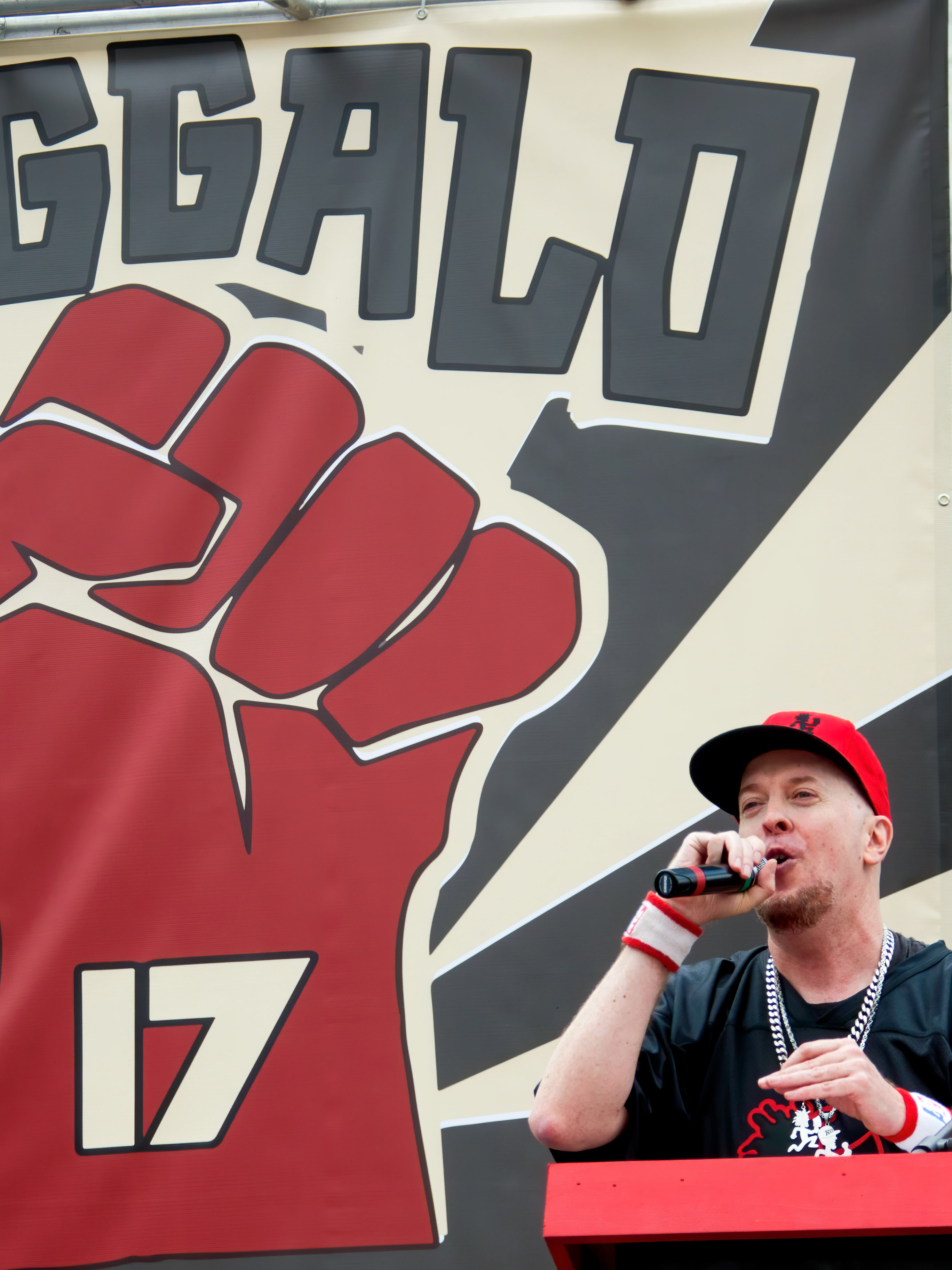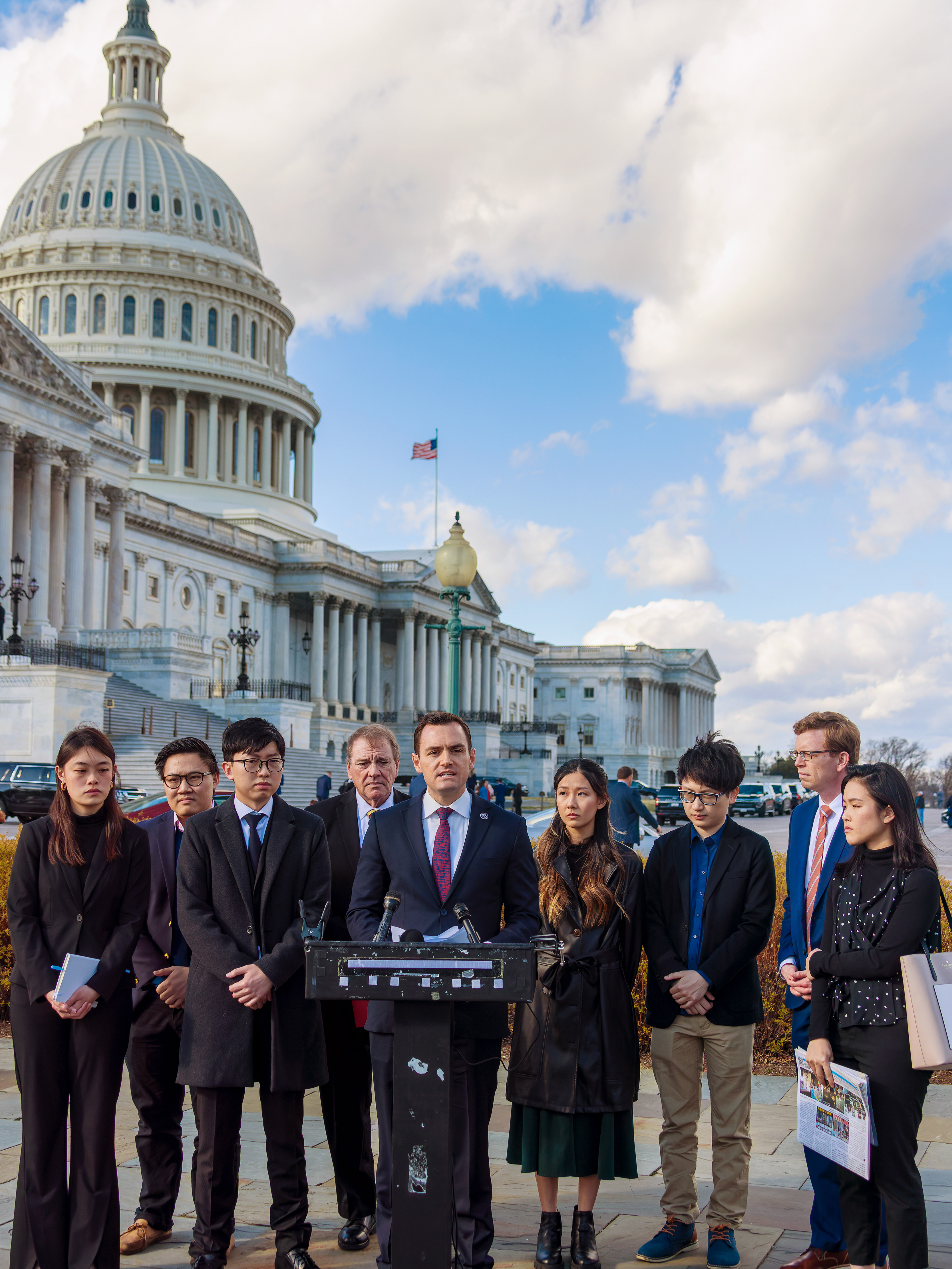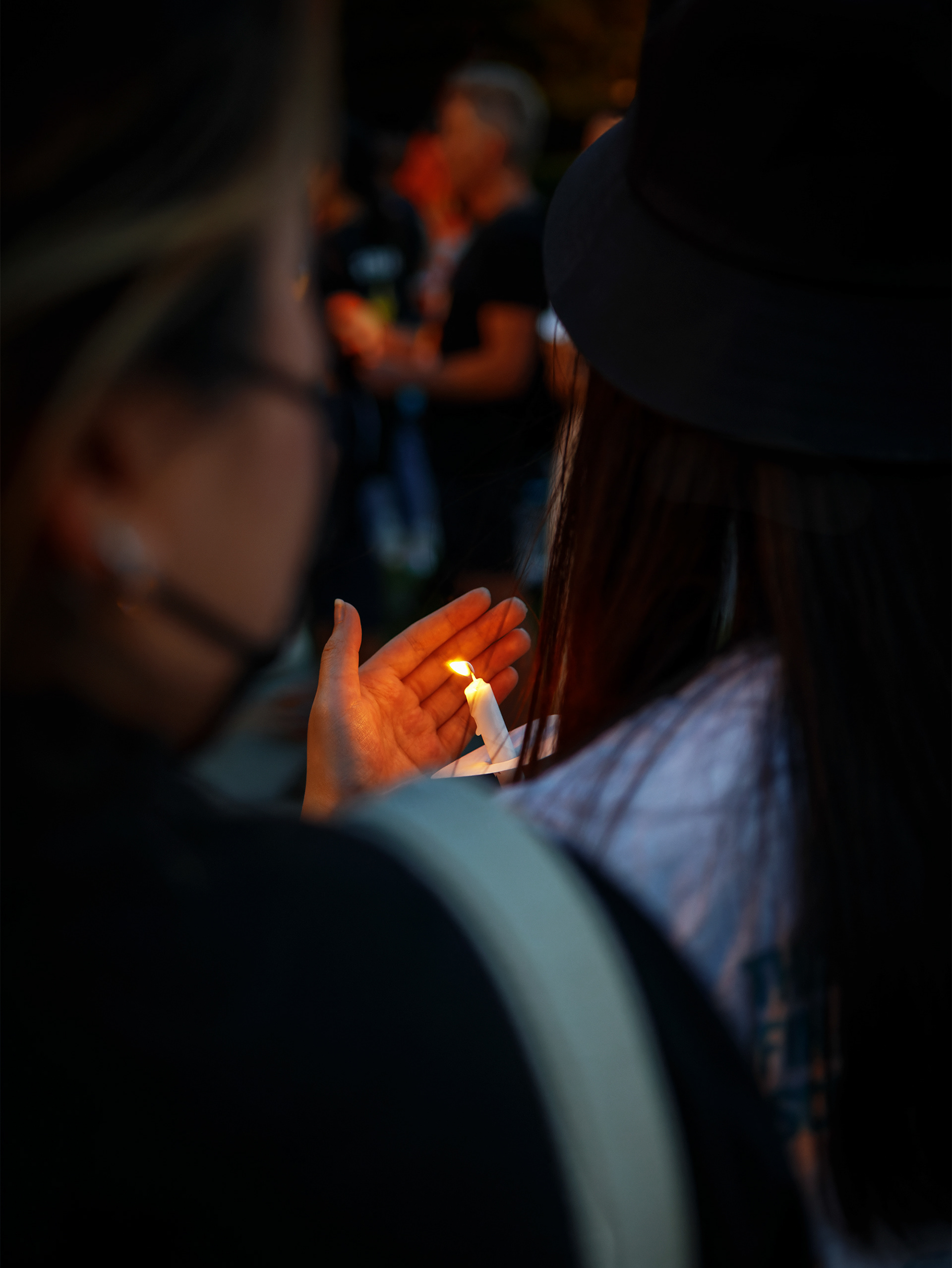This photographic exhibition by Dr. Daniel Garrett was presented at Victims of Communism Memorial Foundation’s Hong Kong Human Rights Forum at the U.S. Capital Visitor Center in Washington, DC on 18 September 2019. It is part of an ongoing personal project to visually document and tell the story of Hong Kong and captures images taken between the end of May and beginning of July 2019. In part, it provides a visual record of Hongkongers’ observances of the 30th Anniversary of the Tiananmen Massacre on 4 June 1989, and the birth of Hong Kong’s 2019 Water Revolution. The Forum, which featured speakers from Hong Kong artists, student leaders, journalists, social workers and American observers and Members of Congress, also showcased artwork and photography by renowned artists Badiucao and Kacey Wong. The Forum occurred in the backdrop of congressional hearings on the deteriorating situation of Hong Kong’s autonomy, limited-democracy, freedoms, way of life and erosion of the “One Country, Two Systems” policy under Chinese Communist Party General Secretary Xi Jinping. Dr. Garrett, after testifying to the Congressional-Executive Commission on China, and speaking at the Forum, was subsequently denied re-entry to Hong Kong by Chinese and Special Administrative Region authorities
"The (Tiananmen) Shadow Looming Over Hong Kong"
This montage is of a visual essay – “The (Tiananmen) Shadow Looming Over Hong Kong” – by Daniel Garrett that appeared in Cha: An Asian Literary Journal’s June/July 2019 issue, Tiananmen Thirty Years On. Capturing moments in time during and surrounding Hong Kong’s annual Tiananmen remembrance activities and candlelight vigils under Communist China’s looming shadow of the 8964 massacre and the on-going Murder of Hong Kong, the essay visually alludes to parallels between Red China’s crackdown on pro-democracy protesters in both places. In casting the Hong Kong police as the Chinese Communist Party’s “Little gun” in the Special Administrative Region, the essay invokes the post-2014 multi-year crackdown on the City of Protests’ civil society and protest culture that ultimately provoked the eruption of the Liberate Hong Kong resistance in June 2019.
“Thirty Years On, The Ghost of Tiananmen Haunts Hong Kong”
Ahead of the 30th anniversary of the Tiananmen Square crackdown, Hong Kong artist Dr. Kacey Wong performs an art installation – The Loveliest Person – of the ghost of a People’s Liberation Army soldier involved in the massacre. Playing the funeral version of the Chinese national anthem, the soldier – Death – stalks the street hauntingly serenading the public including anti-extradition-to-China protesters. The performance accentuated the absurdity of “murders” having become synonymous with the “loveliest people” – as the army came to be known during Mao’s reign and as entertained by Peng Liyuan following the butchery of June 4th. A similar absurdity is implied in regime efforts to legitimate the Extradition Law Amendment Bill, which would introduce communist legal and political norms in the city, by equating the Party-state’s Rule-By-Law legal system and lack of human rights protections to those of Hong Kong’s.
State Terrorism
A member of the Hong Kong police’s hated Special Tactical Squad known as the Raptors menacingly toys with the nozzle of a pepper spray jet pack while facing journalists, bystanders and anti-extradition protesters on the morning of June 12th at Tim Wa Avenue located between the Special Administrative Region government complex and the People’s Liberation Army Hong Kong Garrison barracks. Hours later the police would launch an unprecedented brutal assault on anti-extradition demonstrators and bystanders, the first of many to come in the following weeks. Calls for an independent commission of inquiry regarding police conduct and use of force to violently suppress protests is one of five key demands the anti-extradition movement has made of the Special Administrative Region authorities.
We Are Hongkongers ...
Tens of thousands of anti-extradition protesters on Tim Wa Avenue seeking to disrupt the second reading of the Extradition Law Amendment Bill (ELAB) by the Legislative Council on June 12th occupy the areas surrounding the Special Administrative Region government complex that morning. The proposed ELAB would impose communist legal and political norms on Hong Kong that criminalize here-to-before protected anticommunist and other speech and would allow dissidents and other regime critics to be extradited to China. Standing at the barricades just yards from riot-geared Hong Kong police, Liberate Hong Kong freedom fighters display their iconic umbrellas, hardhats, and googles that have become synonymous with the post-2014 pro-democracy movement in the “City of Protests.”
War pigs ...
A riot-gear equipped Hong Kong police officer outside the Special Administrative Region government complex knocks his baton eagerly against the edged of his shield in seeming anticipation of a coming confrontation while staring at anti-extradition protesters facing Tim Wa Avenue on the morning of June 12th. Ironically, hundreds of mills barriers like the one the officer is resting on have become inadvertent building materials for demonstrator’s own barricades to prevent the police from attacking them and recovering areas “liberated” by demonstrators.
Two Million Hongkongers Say:
No Extradition to China
No Extradition to China
Placards and slogans decrying Hong Kong police’s unprecedented violence and brutality on June 12th outside the Special Administrative Region government complex against anti-extradition occupiers and the subsequent raiding of hospital emergency rooms and admission/treatment records to identify and arrest injured demonstrators at other protests were prominent visual claims articulated during the two-million-plus “No Extradition to China” march on June 16th.
Help Hong Kong, Save Hong Kong:
Hong Kong Human Rights and Democracy Act
Hong Kong Human Rights and Democracy Act
Anti-extradition demonstrators during Hong Kong’s two-million-plus march on June 16th express support for the United States’ proposed Hong Kong Human Rights and Democracy Act. Similar placards and messages can be frequently seen during anti-extradition protests, and on the city’s now ubiquitous Lennon Walls. The Chinese Communist Party, its Special Administrative Region apparatchiks, and supporters have labeled these and other democracy and freedom loving Hongkongers calling for the Hong Kong Human Rights and Democracy Act’s passage traitors and have threatened them with political violence and prosecution by mainland authorities. Enactment of the Extradition Law Amendment Bill by the Special Administrative Region authorities would directly facilitate such transfers under the pretext of China’s national security.
“Hong Kong is NOT China”
The placard, “We are Hong Kong not China, not yet” speaks to the popularly perceived lie that the “One Country, Two Systems” policy has become under the Chinese and Special Administrative Region (SAR) authorities over the last twenty-two years, and of the communists’ accelerating efforts under General Secretary Xi Jinping to transform the city into just another Chinese city. Saliently, the Extradition Law Amendment Bill (ELAB) would introduce mainland legal and political norms in the Region despite Deng Xiaoping’s promises and Hong Kong SAR Basic Law (BL) guarantees not to introduce the communist system in Hong Kong for fifty-years (2047). The ELAB would directly erode Hongkongers’ rights to assembly, free speech and other fundamental rights protected under the BL and encroaches on the SAR’s autonomy by circuitously imposing Chinese national security norms on the Hong Kong system.
Freedom Fighters, Not Rioters
Hongkongers’ outrage at excessive regime violence and brutality on June 12th against anti-extradition protesters outside the Special Administrative Region government complex is matched by their moral indignation at the anti-extradition and pro-democracy movement being labeled by the regime as rioters. Demands for the regime to apologize and withdraw that categorization have become one of five key demands of the anti-extradition movement.
Liberty, or Death
A young protester carries a placard citing American revolutionary Patrick Henry’s famous call to arms “Give me liberty or give me death” during a march to G20 consulates in Hong Kong by hundreds of anti-extradition-to-China demonstrators. The same saying can be frequently discovered on Lennon Walls and seen as political graffiti on urban infrastructure left by frontline “Liberate Hong Kong” freedom fighters. The G20 consulates were implored to defend Hongkongers’ by warning Chinese President Xi Jinping not to use violence to quell the anti-extradition protests.
Defend Our Homeland
Hundreds of anti-extradition-to-China demonstrators rally one evening outside a fenced off-area on Hong Kong’s famous Victoria Harbor waterfront promenade. The waterfront dock was to be handed over to the People’s Liberation Army Hong Kong Garrison the following day following extraordinary legislative maneuvers by pro-communist lawmakers that ramrodded the transfer agreement through the parliament. Similar undemocratic legislative shenanigans were used by the Special Administrative Region authorities to push the controversial Extradition Law Amendment Bill forward in the Legislative Council by excluding pro-democracy opposition lawmakers. Here, under the protection of umbrellas, a handful of frontline demonstrators cut the chain-link fenced and entered the restricted area to “reclaim and liberate it” before being shortly forced out by Hong Kong riot police.
"Hallelujah to the Lord"
The night before the Hong Kong police’s unprecedented attack on anti-extradition-to-China demonstrators outside the Special Administrative Region government complex (SARG) on June 12th, a group of peace-minded Christian protesters sought to spiritually mediate between the regime security forces and the frontline freedom fighters by endlessly singing, “Sing Hallelujah to the Lord.” Here, one of the activists sings the hymnal to gathering crowds outside the government forecourt known as Civic Square – the arguable site of the 2014 Umbrella Movement. In the days following the egregious regime violence of 612 against protesters, activists prayed and sang the hymn for days on a flyover to the SARG complex guarded by police.
Hong Kong’s Fallen Heroes
A Hongkonger pays respects to the anti-Extradition Law Amendment Bill (ELAB) movement’s first martyr at shrine set-up adjacent to the Lennon Wall at the Special Administrative Region government complex in Tamar. The martyr, a 35-year-old protester wearing a yellow rain jacket (as seen in the image on the left wall and the iconic raincoat on the right side of the photograph), fell to his death while hanging an anti-extradition banner from façade of a high-end mall that lined a major thoroughfare and protest route. This galvanized many in Hong Kong and led to tens-of-thousands leaving flowers, other offerings and making prayers at shrines like this one at Tamar and another at the site of his death. Since then, nearly twelve other Hongkongers connected to the anti-extradition protests have taken their lives.
Martyr Leung: "Ideas Don’t Die”
A “fallen” protest visual in the Legislative Council’s demonstration area that invokes the anti-extradition movement’s first martyr as signified through his iconic yellow raincoat and the immortal promise that “Ideas don’t die.” Pictorial depictions of the martyr and his rain slicker have become ubiquitous images and imagery found in Hongkongers’ on- and off-line anti-extradition political art and communications. It is also not unusual to observe protesters wearing the rain jacket during demonstrations in memory of, and in solidarity of his and others’ sacrifices.
Hong Kong: No Place for Communism
An anti-extradition-to-China protester waves a U.S.-flag and says no to a “communist Hong Kong” marches on July 1st, the 22nd anniversary of the Hong Kong Special Administrative Region. For many displaying American flags at anti-extradition-to-China protests in the city, these are appeals for assistance from the United States of America to hold China accountable for its 1980s-era promises to Hongkongers and the Free World that Beijing – under “One Country, Two Systems” – would maintain the Hong Kong system and Way of Life through 2047 and not impose Chinese communism on the city. It is also a recognition, that the U.S. – for all its foibles – remains an icon of democracy and freedom around the world, the city on the hill. Moreover, the United States is seen as the only country that can stand up to the Chinese Communist Party, its attempts to remake the international liberal order into an illiberal axis, and to deter it from violently repressing the pro-democracy movement in Hong Kong today in 2019 as it did in China in 1989.









